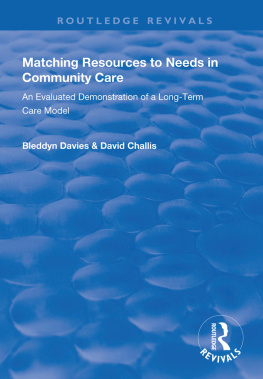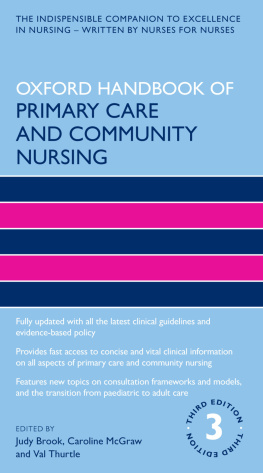Care Management in Social and Primary Health Care
This work was undertaken by the PSSRU, which receives support from the Department of Health; the views expressed in this publication are those of the authors and not necessarily those of the Department of Health.
First published 2002 by Ashgate Publishing
Reissued 2018 by Routledge
2 Park Square, Milton Park, Abingdon, Oxon OX14 4RN
711 Third Avenue, New York, NY 10017, USA
Routledge is an imprint of the Taylor & Francis Group, an informa business
Copyright Personal Social Services Research Unit 2002
All rights reserved. No part of this book may be reprinted or reproduced or utilised in any form or by any electronic, mechanical, or other means, now known or hereafter invented, including photocopying and recording, or in any information storage or retrieval system, without permission in writing from the publishers.
Notice:
Product or corporate names may be trademarks or registered trademarks, and are used only for identification and explanation without intent to infringe.
Publishers Note
The publisher has gone to great lengths to ensure the quality of this reprint but points out that some imperfections in the original copies may be apparent.
Disclaimer
The publisher has made every effort to trace copyright holders and welcomes correspondence from those they have been unable to contact.
A Library of Congress record exists under LC control number: 2002102838
Typeset by Nick Brawn at the PSSRU, University of Kent at Canterbury.
ISBN 13: 978-1-138-73771-6 (hbk)
ISBN 13: 978-1-315-18521-7 (ebk)
There are very many people whom we should like to thank for their contribution to this work and not all can be mentioned individually. We owe a particular debt to our colleagues closely involved in implementing and managing the programme. First the social services department staff who implemented the scheme. The care managers during the evaluation phases of the scheme, Jean Braban, Pam Royce and Jan Wilkinson, provided creative and imaginative approaches to support at home. Sheila Renton provided a very effective administrative service, developing systems to manage micro budgets. Bob Woods was responsible for the managerial initiative for the establishment and implementation of the scheme from the beginning. The NHS care managers, Carol Graham and Alyson Thomson were also creative in developing packages of care spanning the health and social care divide. Dr Ian Bowns undertook medical assessments in the health and social care scheme and was a source of infectious enthusiasm. Margaret Edwards played an important role in developing rehabilitation activities in the community. It is their work that has made the scheme a success and they are in a true sense co-authors. At the PSSRU, Nick Brawn typeset the manuscript with his usual skill.
We should like to thank the Department of Health, which funds the Personal Social Services Research Unit; the then Director, Professor Bleddyn Davies, for his personal support; and the Department of the Environment, who provided the initial funding for the social care and health and social care schemes. We are grateful to the elected members of Gateshead Metropolitan Borough for their imagination and courage in backing these initiatives and to the first Director of Social Services, Graham Lythe, for his enthusiasm, support and commitment in introducing the scheme to the department and to his successors, David Stevenson, Barry Taylor and Simon Hart for their continued support.
Dr David Henley and Lesley Longstaff, then of the health authority and community trust respectively, played an important part in developing the health and social care scheme, as did many other staff of the local health and social services.
The care scheme helpers deserve our particular thanks for their contribution in providing support to frail older people. Finally, we are especially indebted to the older people and their families who helped us by participating in careful and sometimes lengthy interviews about the difficulties they experienced in managing to cope at home in the face of extreme disability and frailty.
David Challis, Professor of Community Care Research ,
Director of PSSRU, University of Manchester
John Chesterman, Research Fellow ,
PSSRU, University of Kent at Canterbury
Rosemary Luckett, formerly Team Leader ,
Gateshead Community Care Scheme ,
now Head of Services for Older People, Gateshead Council
Karen Stewart, Research Fellow ,
PSSRU, University of Manchester
Rosemary Chessum, formerly Research Officer ,
Gateshead Community Care Scheme ,
now Area Child Protection Committee Officer, Gateshead Council
1
Care Management, Coordinated and Integrated Care
There has been a longstanding concern to provide integrated and coordinated care for vulnerable older people. This is evident in the long-term care policies of many countries (Kraan et al., 1991; Challis et al., 1994; Campbell and Ikegami, 1999). In the UK, this concern can been seen to have moved from approaches which address inter agency collaboration and joint planning through the 1970s (Webb and Wistow, 1986), towards an increasing emphasis upon integration at the practice level. This is evident in such initiatives as Care in the Community (DHSS, 1981) and most obviously the White Paper Caring for People (Cm 849, 1989). The latter marks the point at which policy focuses both on macro and on micro level initiatives to promote these goals at the same time. In that policy document assessment and care management were framed as the cornerstone of high quality care. In the recent White Paper Modernising Social Services (Cm 4169, 1998) the importance of coordination, clarity of role, flexibility of services and efficiency are again stressed. Key areas for action are the promotion of independence, improving consistency and providing convenient user-centred services. These activities are set in a context of more macro level integration reflected in the development of partnerships between health and social care (Department of Health, 1998b). This is particularly evident in proposals to create care trusts and the growing leadership importance of primary care exemplified in the current emergence of primary care trusts (Cm 4818-1, 2000). Care management can thus be seen as a field level mechanism for coordinating care, which links into the more macro issues of commissioning, service development and joint working.
This book examines intensive care management for frail older people, designed to provide a realistic community-based approach to long-term care for vulnerable people.
Current issues in care management
The contribution of care management to the long-term care of older people spans the policy agenda of the 1990s and that of the new millennium (Warburton and McCracken, 1999). However, following its introduction in mainstream social care in the UK, there appear to be a number of concerns regarding certain aspects of the approach that have been relatively poorly developed. In a review of care management implementation, as part of an evaluation of the impact of Caring for People , five key areas for development were identified







